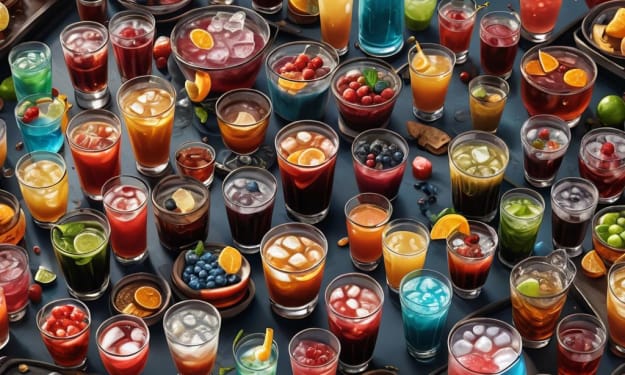What to Know About Canadian Ice Wine
A lot has been said and written about red wine and white wine; from their look to their taste—but what do we know about Canadian Ice Wine?

Ice Whaaat? You may ask. Yes, ice wine. See, most people tend to associate Canada’s sub-zero temperatures with naked lands, essentially no life—but the truth is, since 1984, Ontario has found a use for these unforgiving temperatures in grape production.
With the nearly-ideal climate for the reliable production of ice wine: warm summers to ripen the grapes and cold winters, Canada has been the global leader in the production of ice wine since 1991, surpassing Germany and Australia.
You are dying to know how it’s made. Well, welcome to one of the world’s most misery-stricken wine production techniques. The Canadian ice wine is made from approved grape varieties that have been left to freeze naturally on the vine, usually below -8 degrees Celsius. I am sure you are imagining yourself in one of the world’s most hostile environments, out in the dark monitoring temperatures and harvest the frozen grapes. You should. Because this is what it takes to attain that luscious taste! But before you decide to indulge yourself in a glass or two of the tasty Canadian ice wine, here’s four things to know about it.
Canadian Ice Wine 101: How is it made?

While ice wine's harvest and production methods differ from one culture to another, the Canadian version follows an age-old tradition that leaves grapes in the vines after all the regular grapes are harvested. To kick-start the process, grapes are left at sustained temperatures below -7 degrees Celsius for not less than 24 hours.
Most grape growers across Ontario prefer to cover their grapes in nets during autumn to protect them from birds. Grape growers and wineries then watch and monitor the weather for the optimum stretch of a -7 degrees Celsius to -10 degrees Celsius range. According to the Wine Country Ontario, this is the optimum range that guarantees very sweet juice in the range of 35°Bx to 39°Bx (a measurement of sugar). After a 24-hour exposure to these temperatures, grapes are handpicked at night and basket-pressed immediately to extract the sweet juice leaving water behind as ice.
Owing to the low temperatures and age, ice wine grapes' yields are lower than those of table wines. Perhaps this explains why Ontario wineries produce a dismal 65,000 cases per season. Extracted juice is left to settle for two to four days before fermentation. The Wine Country Ontario notes that the relatively high sugars of ice wines pose significant challenge to the fermentation process, as the hostile environment created by high sugars causes the yeast to stop prematurely, leading to low alcohol levels.
Serving Canadian Ice Wine
Traditionally, ice wine is served chilled. However, I would advise against serving it too cold to avoid losing the all-too-important flavours. Although it is acceptable to accompany it with strongly-flavored foods, such as aged blue cheese or dark chocolate, ice wine is called “desert wine” for a reason!
Therefore, I recommend you serve it alone as a dessert. This way, you are sure to not miss its unique aromas and flavors of exotic and tropical fruits. Despite being relatively high in sugar, the Canadian ice wines are richly acidic—providing the ideal balance for a full-bodied drink.
Ice wine, unlike the conventional table wine, is served in relatively smaller wine glass. And note that, while it’s not a crime to serve ice wine in bigger glasses, the Canadian ice wine stands for uniqueness. Therefore, it's best to stick with the practices that make it stand out. If serving with other foods, I would recommend strongly-flavoured foods. Wine Folly also recommends serving ice wine with “somewhat subtle desserts” to achieve ideal taste profile. For wine lovers that prefer late night snacks, serving ice wine with a softer cheese is the way to go.
There is a host of wannabe-Canadian ice wines.

The Vintners Quality Alliance (VQA) Act, which sets industry standards for grape varieties, harvest, production, and testing before the ice wines are released for sale, regulates Canadian ice wine. Having said this, you are probably thinking that you could look everywhere and never find a single non-Canadian ice wine with the word ‘Icewine.’ Guess again!
Although the regulatory body forbids the use of 'Icewine' in labels unless the wine originates from Ontario and is VQA-certified, the ice wine industry is just too lucrative to allow the Canadians have all the fun! The overall success of the Canadian ice wine has inspired an ever-growing counterfeit market from Western Europe all the way to Shanghai.
For the wine lovers looking to buy a bottle of their favorite ice wine from a Canadian liquor store, they have absolutely nothing to fear. For you overseas, beware of cheap alternatives! All hope is not lost though, as the presence or absence of a VQA logo is the distinctive feature meant to help you tell the real stuff from the fakes.
Canadian ice wine is not cheap!
Yes. I said so! Anyone would be forgiven for thinking that they can buy ice wine for half the price of the Canadian ice wine. Of course they can. The only difference is that they will not be enjoying the quality and intense flavors only offered by Ontario-made ice wine.
See, ice wine from Canada is not cheap in every sense of the word. For one, the high cost of production is the sole reason why Canadian ice wines are sold in half bottles. With a typical 375 ml bottle retailing at over $50, if you were to stop by a vendor selling it way below the $50 mark, chances are you would be buying a fake!
Second, you don’t expect every other host to serve you the Canadian ice wine. Because of its rareness, it remains a telling feature of the who’s who in society. So, if you were to attend a cocktail party in, say Singapore, and you were served the unmistaken Ontario-made ice wine, you would instantly think highly of your host. All being said, it suffices to point out that this version of wine is made for those who love the finer things in life.
Feeling like a Canadian ice wine pro and ready to indulge?

Ask any info savvy person what they know about Canada, and you are likely to hear things like; ice hockey, poutine, skiing, and the Canadian GP. But how about ice wine? Given the familiar images of unforgiving sub-zero temperatures, one would be forgiven for thinking little of Canada regarding winemaking. That’s why it should come as a surprise that Canada is the world’s leading ice wine maker.
The strategically placed seasons: autumn and winter, provide the ideal weather for growing and harvesting grapes that are suitable for making ice wine. After years of tightly regulated growing, harvesting, and production, tasting process, Ontario has emerged as the global leader of ice wine making.
Even so, the tight regulations have been unable to deter mushrooming counterfeits; but for the keen wine lover, I would recommend checking wine bottles for a VQA logo to help you tell the difference. Once you have the real stuff, remember to serve it chilled and alone. I mean, it’s called “dessert wine” for a very good reason!
About the Creator
DollarBilcopy
Hey, I'm Bil, a recovering academic and sucker for the written word.






Comments
There are no comments for this story
Be the first to respond and start the conversation.